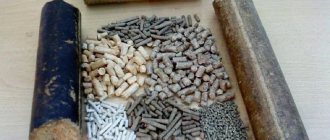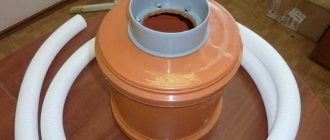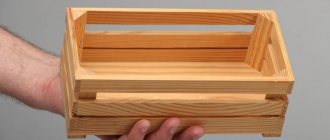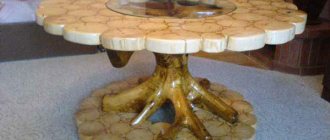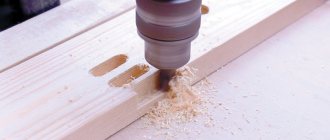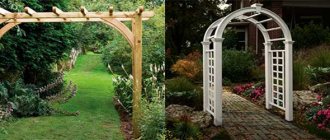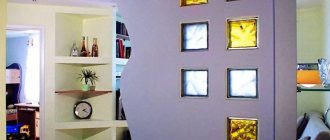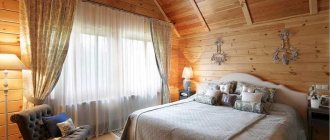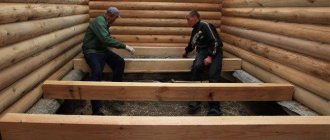A simple staircase made from decking boards is a relatively inexpensive but interesting design that you can make with your own hands. Such structures are suitable for gazebos and verandas, serve as an excellent addition to the porch, and are used as elements of the interior interior.
In terms of external texture, the deck board imitates natural wood, although it is a composite material. Thanks to the properties and technical characteristics of WPC (wood-polymer composite), it is ideal for exterior decoration, does not require special care, and is resistant to humid environments and temperature changes.
What is a terrace board
In the assortment of construction stores, decking boards are found under the abbreviation DPK, which stands for wood-polymer composite. Professional finishers call such a board decking. The building material is made from wood chips, polymer resins, pigment components and fillers. Before becoming a finished product, raw materials undergo multi-stage processing, turning into a monolithic material with high strength values.
The advantages of steps made from decking boards are as follows:
- resistance to linear deformation - retains its original appearance and consumer properties even with intensive use;
- textured surface - this structure allows you to save on anti-slip rubber pads;
- neutrality to any external environment - the composite composition does not attract rodents and harmful insects, and is resistant to the appearance of fungus and mold;
- variety – there are no uniform standards in the manufacture of composite boards, so products of all sizes and colors are available for sale;
- safety – the composition does not contain chemically active substances and components, so WPC will not create problems for people suffering from allergic reactions or pathologies of the upper respiratory tract;
- simplicity - installation of the board is quite feasible on your own; during operation, the material does not require special care.
Of course, it was not without some drawbacks. The disadvantages of decking are low resistance to mechanical damage and high cost. The second drawback can be justified by the long service life - at least 15 years, according to manufacturers.
What is the C3 cladding installation technology and why is it preferred?
The technology for installing concrete stair cladding C3 was developed and patented from Tver. In the workshops of the enterprise, monolithic overlays for street steps, facing slabs and finished flights of stairs on concrete and metal stringers are manufactured. The main distinguishing feature of all offered products is the high strength of M1200, and in this indicator they can only be compared with granite.
High frost resistance and low water absorption also deserve attention, but the choice in favor of C3 stairs is often made because they do not slip in any weather. The surface of the coating has a pronounced structural surface with a relief pattern, as in the photo. The appearance of the structures also benefits from this, and we wrote about how decking boards are combined with C3 cladding here:.
Video of cladding using C3 technology:
Preparing the tool
It is impossible to make a porch from a terrace board with your own hands without a certain set of tools. It is impossible to predict all the nuances that may arise during the work process, but at the initial stage it is better to stock up on the following types of tools:
- screwdriver;
- hammer drill with a set of drills of various diameters;
- a circular saw and a fine-toothed disk or hacksaw to cut the board;
- hammer;
- building level;
- roulette;
- fasteners recommended by the decking manufacturer.
In addition, before starting construction, it is necessary to prepare a project for the future structure and draw up a detailed drawing. Don’t forget about personal protective equipment: gloves and goggles are mandatory attributes for any home handyman.
Arrangement of the terrace
The terrace is finished with decking on a flat surface or logs. The flooring should have a slight slope, as when covering a porch, which will not be noticeable visually, but will significantly increase the rate of drainage of melt or rainwater from the surface.
The deck board is fastened in the same way as when installing a porch. It is worth considering that to finish the terrace you need to use wider and thicker decking than for the porch and steps. This will make the surface more resistant to loads and reduce deformation during operation. To decorate large areas, it is better to use a special board with grooves at the ends. By connecting decking to each other, they can be used to obtain a more even surface.
A porch or staircase sheathed with high-quality decking will serve for many years and will not require major repairs. In some cases, WPC finishing boards can be dismantled and reused. This will help you save on purchasing new materials when moving.
Source
Building materials and additional elements
The staircase is part of the building structure, so such flights must comply with the requirements of SNiP. Without going into technical details, the following standards apply to the steps:
- width from 250 mm;
- height no more than 200 mm;
- the recommended angle of inclination of the stairs is 26–45 degrees;
- railing height no more than 110 cm;
- the distance between the vertical elements of the barrier is 100–150 mm.
It should be clarified that these are not mandatory, but recommended requirements, so each master can design a staircase from a decking board according to individual dimensions. However, the characteristics listed above are considered optimal for convenient and safe operation.
In addition to the tools and basic materials listed above, the work process may require hardware, clamps (metal or plastic clips), end caps, profiles and corners.
Stages of installation work
Installation of decking begins with preparing the base. To prevent the porch steps from sagging after a certain time, a small foundation is poured under the stairs. While the base dries and gains strength (on average 1–2 days), you can start preparing building materials and sawing the WPC according to the required dimensions.
Installation work is carried out according to the following scheme.
First, the logs are laid. These elements are mounted directly to the base, fixed to the foundation with self-tapping screws or dowel nails. The location of the joists should always be parallel to the staircase descent. Recommended distance between individual elements: 40–50 cm. Logs are necessary for laying the porch and steps.
When the installation of the frame is completed, steps are laid from the prepared decking board.
Note! Work is always carried out from the porch to the base, the starting step is attached to the surface of the porch with clamps.
After the first, the second and subsequent stages are installed. The second decking is also attached to the joists with connecting clips, maintaining a small gap between the steps of 15–20 mm. This distance is maintained throughout the entire flight of stairs. The gap is designed to compensate for the expansion of the board caused by temperature.
Install risers. A metal corner is placed between the steps, which will serve as the basis for attaching risers: vertically located boards that give the stairs a more interesting and complete look.
At the last stage of construction, the end parts are covered with decorative overlays, which are screwed to the terrace board with self-tapping screws.
Interior staircase trim
Before you begin covering the interior stairs with WPC material, you should clean and level the surface using a jigsaw. When finishing the concrete base, the surface is ground, and after removing the cement chips, the concrete steps are wiped with a wet rag and primed. Before installing the steps, wooden bases are checked for defects.
- You need to start installing steps (or treads) from the top.
- The riser is attached vertically under the installed board with glue so that there is a gap left to the bottom threshold equal to the width of the panel used for the steps.
- The bottom step is attached with glue and pushed under the riser into the gap formed.
- The corner formed by the steps and riser can be closed with a special decorative corner.
You cannot walk on the sheathed stairs during the day, so as not to move the fixed elements.
Don’t forget about covering a certain part of the stairs
Design options
The attractiveness of WPC for the construction of stairs is due to the fact that this material allows the implementation of any design solutions. From the decking you can make a standard rectangular staircase for the porch to the house or make a twisted composition that will gracefully go to the second floor.
It is noteworthy, but risers for decking stairs are not a prerequisite. The free space between the steps gives the structure an original appearance.
As a fence, you can use traditional vertical balusters made of solid wood with figured cutting and wooden or plastic railings. If funds allow, you can order a metal fence, for example, artistic forging.
How to choose quality material
Depending on the type of profile, plastic terrace boards come in two categories:
- full-bodied;
Full-bodied
- hollow.
Hollow
Solid profiles withstand high impact loads. Successfully used in public places:
- summer cafes;
Summer cafes
- verandas;
Veranda
- decks of ships;
Deck
- piers;
Pier
- berth.
Berth
For the hollow profile, the scope of application is all types of terraces. Such products are cheaper in cost.
Terrace
The type of connection of the terrace board is divided into categories:
- suture;
Sutural
- seamless.
Seamless
Installation of seam boards is carried out with a gap of 3-5 mm for the outflow of water using plastic or metal clamps. Using seamless boards, you can create more monolithic surfaces; the use of clamps is not required.

